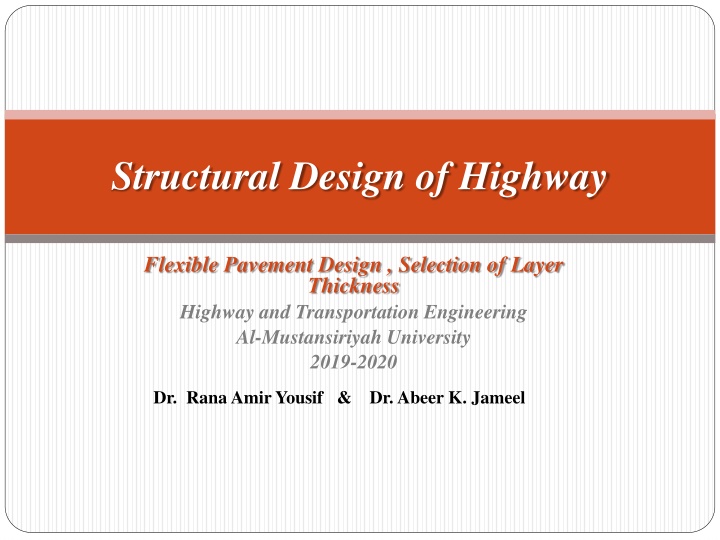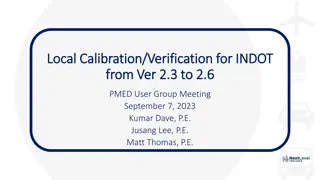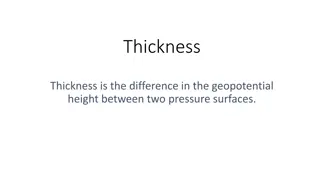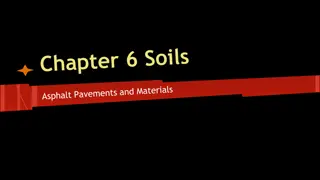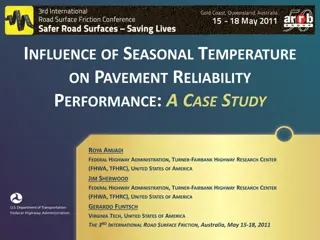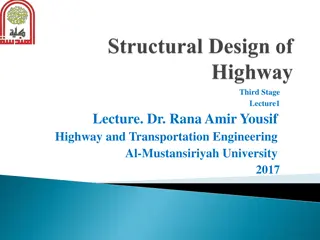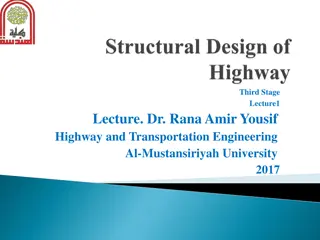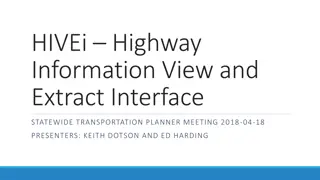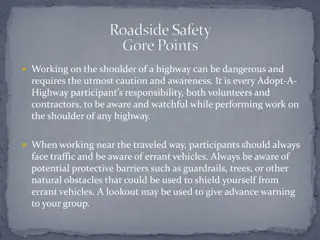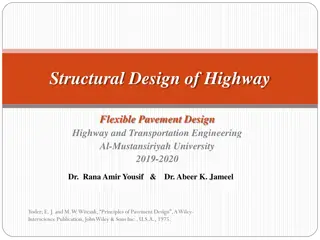Selection of Layer Thickness in Highway Flexible Pavement Design
Selection of layer thickness for highway flexible pavement design involves determining an initial pavement structure's design structural number and then choosing appropriate thicknesses to meet or exceed the required structural number. Cost-effectiveness, construction constraints, and maintenance considerations play crucial roles in selecting the optimal thickness combination to ensure practical and economical designs. The process typically begins by determining the necessary structural numbers for different pavement layers and computing the corresponding thicknesses based on the roadbed soil properties. Various factors such as minimum thickness requirements, material properties, and traffic considerations influence the thickness selection process in flexible pavement design.
Download Presentation

Please find below an Image/Link to download the presentation.
The content on the website is provided AS IS for your information and personal use only. It may not be sold, licensed, or shared on other websites without obtaining consent from the author.If you encounter any issues during the download, it is possible that the publisher has removed the file from their server.
You are allowed to download the files provided on this website for personal or commercial use, subject to the condition that they are used lawfully. All files are the property of their respective owners.
The content on the website is provided AS IS for your information and personal use only. It may not be sold, licensed, or shared on other websites without obtaining consent from the author.
E N D
Presentation Transcript
Structural Design of Highway Flexible Pavement Design , Selection of Layer Thickness Highway and Transportation Engineering Al-Mustansiriyah University 2019-2020 Dr. Rana Amir Yousif & Dr. Abeer K. Jameel
11.3 AASHTO METHOD 11.3.5 Selection of Layer Thicknesses Once the design structural number SN for an initial pavement structure is determined , it is necessary to select a set of thicknesses so that the provided SN, as computed by Eq.11.35, will be greater than the required SN. Note that Eq.11.35 does not have a single unique solution . Many combinations of layer thicknesses are acceptable, so their cost effectiveness along with the construction and maintenance constraints must be considered to avoid the possibility of producing an impractical design . From a cost-effective view point, if the ratio of costs for HMA and granular base is less than the corresponding ratio of layer coefficients times the drainage coefficient, then the optimum economical design is to use a minimum base thickness by increasing the HMA thickness . Yaug H. Huang, Pavement Analysis and Design , Prentic Hall Inc., U.S.A., 1993.
11.3 AASHTO METHOD 11.3.5 Selection of Layer Thicknesses Minimum Thickness It is generally impractical and uneconomical to use layers of material that are less than some minimum thickness . Furthermore, traffic considerations may dictate the use of a certain minimum thickness for stability . Table 11.21 shows thicknesses of asphalt surface and aggregate base . Because such minimums depend somewhat on local practices and conditions, they may be changed if needed. the minimum Yaug H. Huang, Pavement Analysis and Design , Prentic Hall Inc., U.S.A., 1993.
11.3 AASHTO METHOD 11.3.5 Selection of Layer Thicknesses General Procedure The procedure for thickness design is usually started from the top, as shown in Figure 11.28 and described as follows: Yaug H. Huang, Pavement Analysis and Design , Prentic Hall Inc., U.S.A., 1993.
11.3 AASHTO METHOD 11.3.5 Selection of Layer Thicknesses 1. Using E2 as MR, determine from Figure 11.25 the structural number SN1 required to protect the base, and compute the thickness of layer 1 from Step 1 2. Using E3 as MR, determine from Figure 11.25 the structural number SN2 required to protect the sub-base, and compute the thickness of layer 2 from Step 2 Yaug H. Huang, Pavement Analysis and Design , Prentic Hall Inc., U.S.A., 1993.
11.3 AASHTO METHOD 11.3.5 Selection of Layer Thicknesses 3. Based on the roadbed soil resilient modulus MR, determine from Figure 11.25 the total structural number SN3 required, and compute the thickness of layer 3 from Step 3 Yaug H. Huang, Pavement Analysis and Design , Prentic Hall Inc., U.S.A., 1993.
11.3 AASHTO METHOD 11.3.5 Selection of Layer Thicknesses Example 11.12 : Figure 11.29 is a pavement system with the resilient moduli, layer coefficients, and drainage coefficients as shown . If predicted ESAL = 18.6 * R = 95%, So = 0.35 and PSI = 2.1 select thicknesses Dl , D2 , and D3 . FIGURE 11 .2 9 Example 11 .12 (1 psi = 6 .9 kPa) . Yaug H. Huang, Pavement Analysis and Design , Prentic Hall Inc., U.S.A., 1993.
Solution : with 11.3 AASHTO METHOD 11.3.5 Selection of Layer Thicknesses Yaug H. Huang, Pavement Analysis and Design , Prentic Hall Inc., U.S.A., 1993.
11.3 AASHTO METHOD 11.3.5 Selection of Layer Thicknesses Note that a surface thickness of 8 in . (203 mm) and a base thickness of 7 in . (178 mm) meet the minimum thicknesses shown in Table11.21 . Yaug H. Huang, Pavement Analysis and Design , Prentic Hall Inc., U.S.A., 1993.
11.3 AASHTO METHOD 11.3.5 Selection of Layer Thicknesses Yaug H. Huang, Pavement Analysis and Design , Prentic Hall Inc., U.S.A., 1993.
Structural Design of Highway Dr. Rana Amir Yousif & Dr. Abeer K. Jameel Yaug H. Huang, Pavement Analysis and Design , Prentic Hall Inc., U.S.A., 1993.
